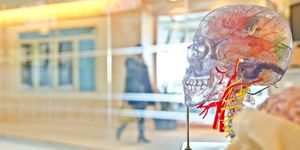A Critical Step in the Development of Brain Disease is ID'ed
Some brain diseases including mad cow disease and the human counterpart Creutzfeldt-Jakob disease (CJD), Kuru, and fatal familial insomnia occur when proteins convert into a misfolded, diseased form. These misfolded proteins can build up, ultimately leading to the death of brain cells. While it may take years for some of these diseases to show any symptoms, they are fatal.
Researchers have now learned about the conversion of normal proteins into a pathogenic form. The findings have been reported in the Proceedings of the National Academy of Sciences, and they may help scientists develop strategies to prevent the formation of improperly folded proteins, called prions.
"Prion diseases are aggressive and devastating, and currently there is no cure," said lead study researcher Alfonso De Simone, a Professor in the Department of Life Sciences at Imperial College London. "Discovering the mechanism by which prions become pathogenic is a crucial step in one day tackling these diseases, as it allows us to search for new drugs. Now we know what we're targeting, we know what features drugs need to have to stop prions becoming pathogenic."
This study used a mutant, more aggressive form of a prion found in people that have an inherited prion disease, as well as computational tools and nuclear magnetic resonance spectroscopy to reveal the structure of a protein as it converts from a normal to a misfolded, pathogenic form.
"The intermediate stage of prion pathogenesis is so transient it's like a ghost - almost impossible to image," said study co-author Dr. Maximo Sanz-Hernández. "But now we have a picture of what we're dealing with, we can design more specific interventions that can one day potentially control these devastating diseases."
The investigators used the data to create antibodies to target this mechanism. They successfully prevented prions from changing from a normal to a pathogenic state. However, these antibodies are currently too large to bypass the blood-brain barrier. Although this study showed that it may be possible to stop prions from causing disease, a lot more work will be necessary before patients can be treated with this approach.
"This is early-stage research examining the short protein fragments, which can be highly unstable, short-lived, and notoriously difficult to study," explained Dr. Rosa Sancho, Head of Research at Alzheimer's Research UK.
"As the UK's leading dementia research charity, we are pleased to fund this sophisticated work using biophysical and computational approaches to better understand the role fragments like this play in the development of disease. To identify new ways to reduce or combat these protein fragments in human disease we need to see sustained investment in dementia research."
The study authors are also hoping that other scientists will check for drug compounds in their libraries that could disrupt the process.
Sources: AAAS/Eurekalert! via Imperial College London, Proceedings of the National Academy of Sciences









